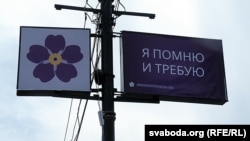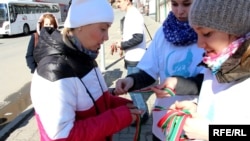As the countries of the former Soviet Union prepare, with varying degrees of enthusiasm, to mark Victory Day, many are making a conscious effort to distance themselves from the orange-and-black St. George ribbon that many now associate with Russian military aggression, separatism, and war.
Baltics
Lithuania, Latvia, and Estonia have formally disassociated themselves from Victory Day commemorations -- it is not counted among their public holidays, although unofficially it is marked on May 8, according to the Western European calendar.
The countries have banned all symbols tied to the Russian Empire, Soviet communism, and national Socialism. The bans, however, do not extend to the St. George ribbon, which has its origins in the reign of Catherine the Great but was only formally resurrected by Russia in 2000.
While no one is punished for wearing the ribbon, they are generally frowned upon for fear of stirring separatist sentiment among the Baltic countries' Russian-speaking populations.
Belarus
The country's mercurial president, Alyaksandr Lukashenka, who is currently running cool on Russia, recently ordered state ideologues to create a local alternative to the St. George ribbon. They responded with an image of blushing apple blossoms atop a bow in the red-and-green colors of the Belarusian flag.
While stressing that people were still free to wear the St. George ribbon -- which, after all, is manufactured from Belarusian thread -- Lukashenka said the new design brought a sense of "national identity" to the Victory Day holiday. (Russian bloggers reportedly sniffed that if national identity was the goal, the ribbons should rightly be the color of potatoes.)
Not everyone is thrilled with the new design.
"Instead of turning to professionals, our authorities continue to do everything in the Soviet way. They have no trust in new artistic concepts," says Belarusian artist and writer Artur Klinau. "But having an alternative to the St. George ribbon is good in and of itself, and I mean this sincerely."
Moldova
Moldova, with its history of different allegiances during World War II, finds it politic to go without a Victory Day holiday. Pro-Western lawmakers, meanwhile, have left no stone unturned in their attempt to weaken Russia's ideological grip on the country. Members of the Liberal Party have even submitted draft legislation that proposes to level stiff fines for using the St. George ribbon -- the equivalent of up to $120 for private individuals and as much as $250 for those in public office.
The lawmakers, ever-mindful of the Russian presence in breakaway Transdniester, say the orange-and-black motif has become a symbol of separatism, lawlessness, chaos, and the loss of hundreds of lives.
Ukraine
Kyiv last month cut off some of the final connections to its Soviet World War II heritage, abolishing the term Great Patriotic War -- favored by Russia -- and declaring the crimes of Bolshevism and Nazism equal in gravity. They also abandoned the carnation as the visual motif associated with Victory Day in Russia, opting instead for a red poppy and ribbons in the light blue and yellow of the Ukrainian flag.
In addition, Ukraine this year begins to celebrate its Victory Day on May 8, according to European tradition.
Central Asia
Kazakhstan has been a stalwart member of most of Russia's post-Soviet integration projects. Even so, the country this year stealthily introduced its own Victory Day ribbon -- a variation on the gold-on-blue motif of its national flag.
Kyrgyzstan has followed suit, preparing for Victory Day commemorations by ornamenting its major cities with the red and yellow colors of its flag. Officials say the red symbolizes valor, courage, and victory; the yellow, peace and tranquility.
Young people and intellectuals in Tajikistan, meanwhile, have informally called for the idea of banning the St. George ribbon as a way of protesting creeping Russian influence.
Uzbekistan is ornamenting its Victory Day wreaths with flag-green ribbons rather than red.
And Turkmenistan, the most isolated of the Central Asian states, reserves its idolatry for late leader Turkmenbashi, his successor, Gurbanguly Berdymukhammedov, and the color white.
Caucasus
There are few St. George ribbons in circulation in the South Caucasus, particularly in Georgia.
Armenians, meanwhile, have embraced the purple forget-me-not as their symbol for the 100-year anniversary of the massacre of more than 1 million Armenians by Ottoman-era Turks, the event known by most as the Armenian Genocide.
Russia And Breakaway Territories
In these places, at least, the St. George ribbon has a home.
Russia's Kazan Textile Factory this year upped its production of orange-and-black ribbon from 4,000 kilometers to 10,000, much of which has turned up in Crimea, separatist-held territories in eastern Ukraine, Transdniester, and Georgia's breakaway regions of Abkhazia and South Ossetia.
The material has become so abundant that a number of Russian officials have traded in their lapel pins for entire scarves.
Ironically, it's Kazan -- the site of the ribbon-producing factory -- that's been a rare source of opposition to the St. George ribbon. On April 26, the Day Of Tatar Language, activists in the Tatarstan capital began distributing rival ribbons in the green-and-red colors of the republic's flag.
Some Tatars say the orange-and-black St. George ribbons represent Russia's imperial victory over Kazan.



















